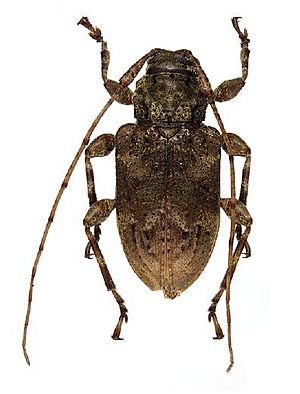Leptostylopsis basifulvus facts for kids
Quick facts for kids Leptostylopsis basifulvus |
|
|---|---|
 |
|
| Scientific classification | |
| Kingdom: | |
| Phylum: | |
| Class: | |
| Order: | |
| Family: | |
| Subfamily: |
Lamiinae
|
| Genus: |
Leptostylopsis
|
| Species: |
L. basifulvus
|
| Binomial name | |
| Leptostylopsis basifulvus Lingafelter & Micheli, 2009
|
|
Leptostylopsis basifulvus is a fascinating type of longhorn beetle. These beetles are known for their very long antennae, which can sometimes be even longer than their bodies! This particular species belongs to a group called Lamiinae, which is a large subfamily of longhorn beetles. Scientists Lingafelter and Micheli first described Leptostylopsis basifulvus in 2009, giving it its official name.
Contents
Discovering Leptostylopsis basifulvus
This special beetle, Leptostylopsis basifulvus, was first identified and named by scientists Lingafelter and Micheli in 2009. When scientists "describe" a new species, it means they carefully study its unique features. They write down details about its size, color, shape, and where it was found. This helps other scientists learn about and identify the beetle in the future.
What Makes Longhorn Beetles Unique?
Longhorn beetles are part of the beetle family called Cerambycidae. They get their name from their very long antennae, which often look like horns. These antennae are not just for show; they help the beetle sense its surroundings. They can use them to find food, mates, and even to navigate.
The Role of Antennae
The antennae of longhorn beetles are packed with tiny sensors. These sensors help the beetle smell, touch, and even taste things in its environment. For example, a beetle might use its antennae to find the right type of tree to lay its eggs on. They are super important tools for these insects!
Where Do Longhorn Beetles Live?
Longhorn beetles, including species like Leptostylopsis basifulvus, can be found in many different parts of the world. They often live in forests and woodlands. This is because their larvae (young beetles) usually develop inside the wood of trees. Adult beetles also spend a lot of their time on or near trees.
Habitat Preferences
Different species of longhorn beetles prefer different types of trees. Some like hardwood trees, while others prefer softwoods. The specific habitat of Leptostylopsis basifulvus would depend on the types of trees it uses for food and reproduction. These beetles play a role in the health of forests.
The Life Cycle of a Longhorn Beetle
Like many insects, longhorn beetles go through a process called complete metamorphosis. This means they have four main stages in their life: egg, larva, pupa, and adult. Each stage looks very different from the others.
Egg Stage
The life of a longhorn beetle begins when the female beetle lays tiny eggs. She usually lays them in cracks or under the bark of trees. The eggs are very small and often hard to spot.
Larval Stage
Once the eggs hatch, tiny larvae emerge. These larvae are often called "wood-borers" because they tunnel into the wood of trees. They spend most of their lives in this stage, eating wood and growing. This stage can last for several months or even a few years, depending on the species and conditions.
How Larvae Eat Wood
Longhorn beetle larvae have strong jaws that help them chew through tough wood. As they eat, they create tunnels inside the tree. This process helps to break down dead or dying trees, which is important for the forest ecosystem.
Pupal Stage
After the larva has grown enough, it changes into a pupa. The pupa is a resting stage where the larva transforms into an adult beetle. This stage usually takes place inside the wood, in a special chamber the larva creates. During this time, the beetle's body completely reorganizes.
Adult Stage
Finally, the adult beetle emerges from the pupa. The adult beetle is what most people recognize as a longhorn beetle. Their main job is to find a mate and reproduce, starting the life cycle all over again. Adult beetles usually live for only a few weeks or months.
What Do Longhorn Beetles Eat?
The diet of longhorn beetles changes depending on their life stage. Larvae eat wood, while adult beetles have different food sources.
Larval Diet
As mentioned, longhorn beetle larvae are wood-eaters. They get all their nutrients from the wood they tunnel through. Some larvae prefer fresh wood, while others prefer decaying wood.
Adult Beetle Diet
Adult longhorn beetles have a more varied diet. Many adult longhorn beetles feed on nectar, pollen, or tree sap. Some might also nibble on leaves or bark. Their diet helps them get the energy they need for flying and finding a mate.
Importance of Longhorn Beetles
Longhorn beetles play an important role in nature. While some species can be pests to trees, many others are helpful.
Decomposers in Forests
Many longhorn beetle larvae help to break down dead or dying trees. By tunneling through the wood, they speed up the process of decomposition. This returns nutrients to the soil, which helps new plants grow. They are like nature's recycling crew!
Food Source for Other Animals
Longhorn beetles, in all their life stages, can be a food source for other animals. Birds, small mammals, and other insects might prey on them. This makes them a part of the forest food web.
See also
 In Spanish: Leptostylopsis basifulvus para niños
In Spanish: Leptostylopsis basifulvus para niños

